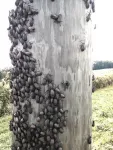INFORMATION:
US deaths normally change less than 2% each year; in 2020, they rose nearly 23%
Black Americans experienced highest per capita excess death rates, while regional surges contributed to higher excess death rates from COVID-19 and other causes, a VCU-led JAMA study finds
2021-04-02
(Press-News.org) Extended surges in the South and West in the summer and early winter of 2020 resulted in regional increases in excess death rates, both from COVID-19 and from other causes, a 50-state analysis of excess death trends has found. Virginia Commonwealth University researchers' latest study notes that Black Americans had the highest excess death rates per capita of any racial or ethnic group in 2020.
The research, publishing Friday in the Journal of the American Medical Association, offers new data from the last 10 months of 2020 on how many Americans died during 2020 as a result of the effects of the pandemic -- beyond the number of COVID-19 deaths alone -- and which states and racial groups were hit hardest.
The rate of excess deaths -- or deaths above the number that would be expected based on averages from the previous five years -- is usually consistent, fluctuating 1% to 2% from year to year, said Steven Woolf, M.D., the study's lead author and director emeritus of VCU's Center on Society and Health. From March 1, 2020, to Jan. 2, 2021, excess deaths rose a staggering 22.9% nationally, fueled by COVID-19 and deaths from other causes, with regions experiencing surges at different times.
"COVID-19 accounted for roughly 72% of the excess deaths we're calculating, and that's similar to what our earlier studies showed. There is a sizable gap between the number of publicly reported COVID-19 deaths and the sum total of excess deaths the country has actually experienced," Woolf said.
For the other 28% of the nation's 522,368 excess deaths during that period, some may actually have been from COVID-19, even if the virus was not listed on the death certificates due to reporting issues.
But Woolf said disruptions caused by the pandemic were another cause of the 28% of excess deaths not attributed to COVID-19. Examples might include deaths resulting from not seeking or finding adequate care in an emergency such as a heart attack, experiencing fatal complications from a chronic disease such as diabetes, or facing a behavioral health crisis that led to suicide or drug overdose.
"All three of those categories could have contributed to an increase in deaths among people who did not have COVID-19 but whose lives were essentially taken by the pandemic," said Woolf, a professor in the Department of Family Medicine and Population Health at the VCU School of Medicine.
The percentage of excess deaths among non-Hispanic Black individuals (16.9%) exceeded their share of the U.S. population (12.5%), reflecting racial disparities in mortality due to COVID-19 and other causes of death in the pandemic, Woolf and his co-authors write in the paper. The excess death rate among Black Americans was higher than rates of excess deaths among non-Hispanic white or Hispanic populations.
Woolf said his team was motivated to break down this information by race and ethnicity due to mounting evidence that people of color have experienced an increased risk of death from COVID-19.
"We found a disproportionate number of excess deaths among the Black population in the United States," said Woolf, VCU's C. Kenneth and Dianne Wright Distinguished Chair in Population Health and Health Equity. "This, of course, is consistent with the evidence about COVID-19 but also indicates that excess deaths from some conditions other than COVID-19 are also occurring at higher rates in the African American population."
Surges in excess deaths varied across regions of the United States. Northeastern states, such as New York and New Jersey, were among the first hit by the pandemic. Their pandemic curves looked like a capital "A," Woolf said, peaking in April and returning rapidly to baseline within eight weeks because strict restrictions were put in place. But the increase in excess deaths lasted much longer in other states that lifted restrictions early and were hit hard later in the year. Woolf cited economic or political reasons for decisions by some governors to weakly embrace, or discourage, pandemic control measures such as wearing masks.
"They said they were opening early to rescue the economy. The tragedy is that policy not only cost more lives, but actually hurt their economy by extending the length of the pandemic," Woolf said. "One of the big lessons our nation must learn from COVID-19 is that our health and our economy are tied together. You can't really rescue one without the other."
According to the study's data, the 10 states with the highest per capita rate of excess deaths were Mississippi, New Jersey, New York, Arizona, Alabama, Louisiana, South Dakota, New Mexico, North Dakota and Ohio.
Nationally, Woolf expects the U.S. will see consequences of the pandemic long after this year. For example, cancer mortality rates may increase in the coming years if the pandemic forced people to delay screening or chemotherapy.
Woolf said future illness and deaths from the downstream consequences of the devastated economy could be addressed now by "bringing help to families, expanding access to health care, improving behavioral health services and trying to bring economic stability to a large part of the population that was already living on the edge before the pandemic." Among other research, his team's 2019 JAMA study of working-age mortality underscores the importance of prioritizing public health measures like these, he said.
"American workers are sicker and dying earlier than workers in businesses in other countries that are competing against America," Woolf said. "So investments to help with health are important for the U.S. economy in that context just as they are with COVID-19."
Derek Chapman, Ph.D., Roy Sabo, Ph.D., and Emily Zimmerman, Ph.D., of VCU's Center on Society and Health and the School of Medicine joined Woolf as co-authors on the paper published Friday, "Excess Deaths From COVID-19 and Other Causes in the United States, March 1, 2020, to January 2, 2021."
Their study also confirms a trend Woolf's team noted in an earlier 2020 study: Death rates from several non-COVID-19 conditions, such as heart disease, Alzheimer's disease and diabetes, increased during surges.
"This country has experienced profound loss of life due to the pandemic and its consequences, especially in communities of color," said Peter Buckley, M.D., dean of the VCU School of Medicine. "While we must remain vigilant with social distancing and mask-wearing behaviors for the duration of this pandemic, we must also make efforts to ensure the equitable distribution of care if we are to reduce the likelihood of further loss of life."
Based on current trends, Woolf said the surges the U.S. has seen might not be over, even with vaccinations underway.
"We're not out of the woods yet because we're in a race with the COVID-19 variants. If we let up too soon and don't maintain public health restrictions, the vaccine may not win out over the variants," Woolf said. "Unfortunately, what we're seeing is that many states have not learned the lesson of 2020. Once again, they are lifting restrictions, opening businesses back up, and now seeing the COVID-19 variants spread through their population.
"To prevent more excess deaths, we need to hold our horses and maintain the public health restrictions that we have in place so the vaccine can do its work and get the case numbers under control."
ELSE PRESS RELEASES FROM THIS DATE:
Most US adults who vape want to quit, study finds
2021-04-02
More than 60% of U.S. adults who vape are interested in quitting, according to a study published today in JAMA Network Open by MUSC Hollings Cancer Center researchers. And among those who vape to help them to quit smoking, some are successful while others continue smoking and using electronic cigarettes.
The study, which analyzed longitudinal survey data from more than 30,000 adults across the country, aimed to provide the most up-to-date estimate of how many Americans are interested in stopping their use of e-cigarettes or have made past attempts to quit.
According to the findings, former cigarette smokers had the highest intentions and interest in quitting. This is likely due to an increasing number of smokers using e-cigarettes to transition away from cigarettes, said the study's authors.
While ...
Excess deaths from COVID-19 and other causes in US
2021-04-02
What The Study Did: This study updates an analysis of deaths in the United States in 2020, including deaths due to COVID-19 as well as all other causes.
Authors: Steven H. Woolf, M.D., M.P.H., of the Virginia Commonwealth University School of Medicine in Richmond, is the corresponding author.
To access the embargoed study: Visit our For The Media website at this link https://media.jamanetwork.com/
(doi:10.1001/jama.2021.5199)
Editor's Note: The article includes funding/support disclosures. Please see the article for additional information, including other ...
Radicalization to extremist ideologies is often triggered by negative life events
2021-04-02
People who radicalize to extremist ideologies often are triggered by negative life events or exposure to propaganda, and those who escape from extreme groups frequently are aided by an individual or group that intervenes to help them reject the philosophy, according to a new RAND Corporation study.
Expanding access to mental health care, creating opportunities for exposure to diverse cultural groups and media literacy education all are important strategies that may aid the battle against extremism, according to researchers. However, harsh law enforcement actions often are unproductive in changing people's extremist beliefs.
The RAND study describes personal accounts based on interviews ...
Fungi could manipulate bacteria to enrich soil with nutrients
2021-04-02
ITHACA, NY, April 2, 2021 - A team of researchers from the Boyce Thompson Institute (BTI) has discovered a distinct group of bacteria that may help fungi and plants acquire soil nutrients. The findings could point the way to cost-effective and eco-friendly methods of enriching soil and improving crop yields, reducing farmers' reliance on conventional fertilizers.
Researchers know that arbuscular mycorrhizal (AM) fungi establish symbiotic relationships with the roots of 70% of all land plants. In this relationship, plants trade fatty acids for the fungi's nitrogen and phosphorus. However, AM fungi lack the ...
How pathogenic bacteria weather the slings and arrows of infection
2021-04-02
Infectious diseases are a leading cause of global mortality. During an infection, bacteria experience many different stresses -- some from the host itself, some from co-colonizing microbes and others from therapies employed to treat the infection. In this arms race to outwit their competition, bacteria have evolved mechanisms to stay alive in the face of adversities. One such mechanism is the stringent response pathway. Understanding how the activation of the stringent response pathway is controlled can provide clues to treat infection.
In new research published this week online in the journal END ...
Lanternfly's attraction to vertical silhouettes could help monitor, trap it
2021-04-02
UNIVERSITY PARK, Pa. -- Like moths to a flame, spotted lanternflies are visually drawn toward and seemingly captivated by vertical objects such as utility poles, a behavior that could be valuable in predicting where the pests might be heading, according to entomologists in Penn State's College of Agricultural Sciences.
Research from the laboratory of Tom Baker, recently published in the Journal of Insect Behavior, is laying the foundation for future strategies to monitor and possibly trap the invasive insect from Asia, which first was found in North America in Berks County, Pennsylvania, in 2014. The planthopper now is confirmed in 34 Pennsylvania counties and several surrounding states.
These findings show that telephone poles attract flight-dispersing ...
Toddler TV time not to blame for attention problems
2021-04-02
Acomprehensive review published in the journal Psychological Science re-examines previous work that claimed to show a direct link between early screen time and attention problems in children. Although other studies do not reflect these findings, the earlier research continues to be widely reported by the media.
"The findings from the original study, upon further scrutiny, are not borne out. We found that there is still no evidence that TV, by itself, causes ADHD or any kind of attention problems in young children," said Wallace E. Dixon, Jr., a professor of psychology ...
Baby aspirin linked to lower risk of colorectal cancer death
2021-04-02
Long-term, regular use of baby aspirin--at least 15 times per month--prior to a diagnosis of colorectal cancer (CRC) may reduce the risk of death from the disease by limiting the spread of cancerous tumors pre-diagnosis, according to a study led by Cedars-Sinai Cancer researchers.
While previous research has offered consistent evidence that low-dose aspirin use reduces colorectal cancer risk, key findings from the study, published in the peer-reviewed Journal of the National Cancer Institute, revealed that the use of baby aspirin prior to the diagnosis of non-metastatic CRC was associated with a lower rate of metastasis, or tumor spread. Starting ...
COVID-19 survivors might need just one dose of two-part vaccine
2021-04-02
LOS ANGELES (April 1, 2021) -- A single dose of the Pfizer-BioNTech vaccine for individuals who previously had COVID-19 generates an immunologic response similar to that of individuals receiving the two-dose recommended sequence, according to a Cedars-Sinai study published today by the journal Nature Medicine.
"Our findings extend those from smaller studies reported elsewhere and support a potential strategy of providing a single dose of vaccine to persons with a confirmed prior history of coronavirus infection, along with two doses for people not previously infected," said Susan Cheng, MD, MPH, MMSc, associate professor of Cardiology and director of Public Health Research at ...
A PTV-based polymer enabled organic solar cells with over 16% efficiency
2021-04-02
Organic solar cell (OSC) is one of the most important green energy technologies. The photovoltaic efficiencies of OSCs are closely related to the photoactive layers, which are prepared by blending electron donor and acceptor materials. With the emergence of a large number of new organic photovoltaic materials and effective molecular modification methods, the photovoltaic efficiency of OSCs has been greatly improved. Accordingly, the molecular structure of the materials is becoming much more complex with high costs, which is difficult to meet the requirements of the industrialization of OSCs. Thus, it is of great importance to develop novel photovoltaic ...
LAST 30 PRESS RELEASES:
Why nail-biting, procrastination and other self-sabotaging behaviors are rooted in survival instincts
Regional variations in mechanical properties of porcine leptomeninges
Artificial empathy in therapy and healthcare: advancements in interpersonal interaction technologies
Why some brains switch gears more efficiently than others
UVA’s Jundong Li wins ICDM’S 2025 Tao Li Award for data mining, machine learning
UVA’s low-power, high-performance computer power player Mircea Stan earns National Academy of Inventors fellowship
Not playing by the rules: USU researcher explores filamentous algae dynamics in rivers
Do our body clocks influence our risk of dementia?
Anthropologists offer new evidence of bipedalism in long-debated fossil discovery
Safer receipt paper from wood
Dosage-sensitive genes suggest no whole-genome duplications in ancestral angiosperm
First ancient human herpesvirus genomes document their deep history with humans
Why Some Bacteria Survive Antibiotics and How to Stop Them - New study reveals that bacteria can survive antibiotic treatment through two fundamentally different “shutdown modes”
UCLA study links scar healing to dangerous placenta condition
CHANGE-seq-BE finds off-target changes in the genome from base editors
The Journal of Nuclear Medicine Ahead-of-Print Tip Sheet: January 2, 2026
Delayed or absent first dose of measles, mumps, and rubella vaccination
Trends in US preterm birth rates by household income and race and ethnicity
Study identifies potential biomarker linked to progression and brain inflammation in multiple sclerosis
Many mothers in Norway do not show up for postnatal check-ups
Researchers want to find out why quick clay is so unstable
Superradiant spins show teamwork at the quantum scale
Cleveland Clinic Research links tumor bacteria to immunotherapy resistance in head and neck cancer
First Editorial of 2026: Resisting AI slop
Joint ground- and space-based observations reveal Saturn-mass rogue planet
Inheritable genetic variant offers protection against blood cancer risk and progression
Pigs settled Pacific islands alongside early human voyagers
A Coral reef’s daily pulse reshapes microbes in surrounding waters
EAST Tokamak experiments exceed plasma density limit, offering new approach to fusion ignition
Groundbreaking discovery reveals Africa’s oldest cremation pyre and complex ritual practices
[Press-News.org] US deaths normally change less than 2% each year; in 2020, they rose nearly 23%Black Americans experienced highest per capita excess death rates, while regional surges contributed to higher excess death rates from COVID-19 and other causes, a VCU-led JAMA study finds







